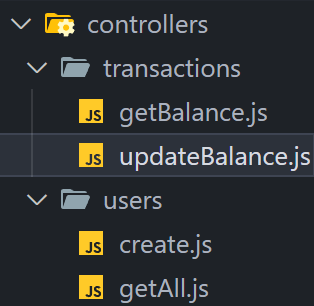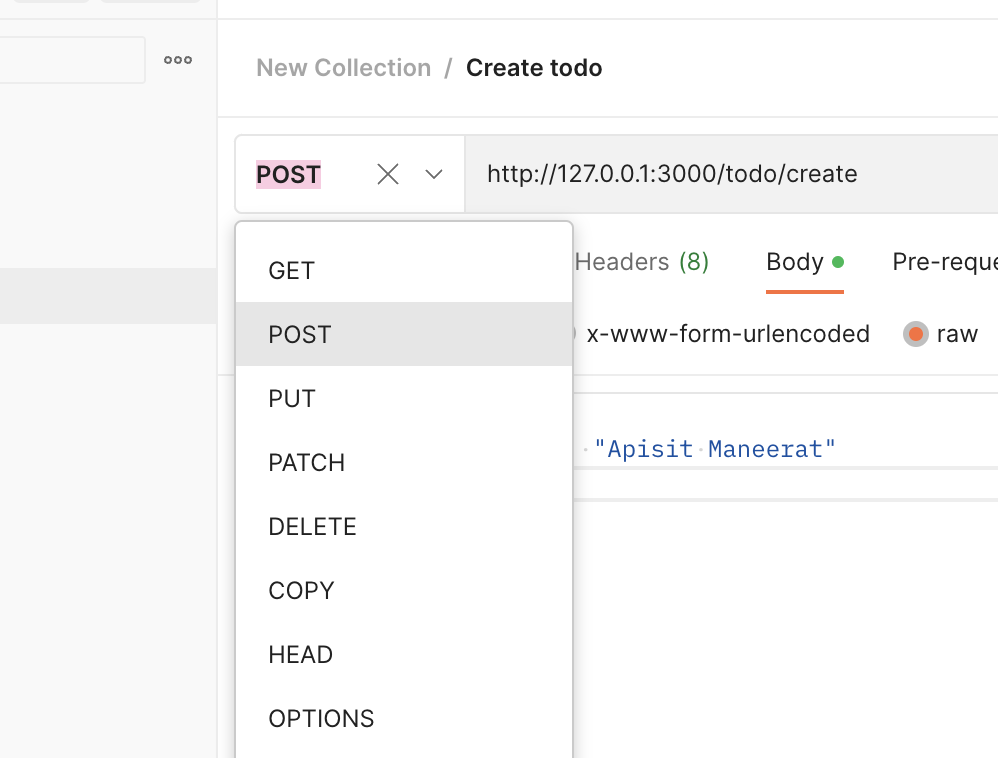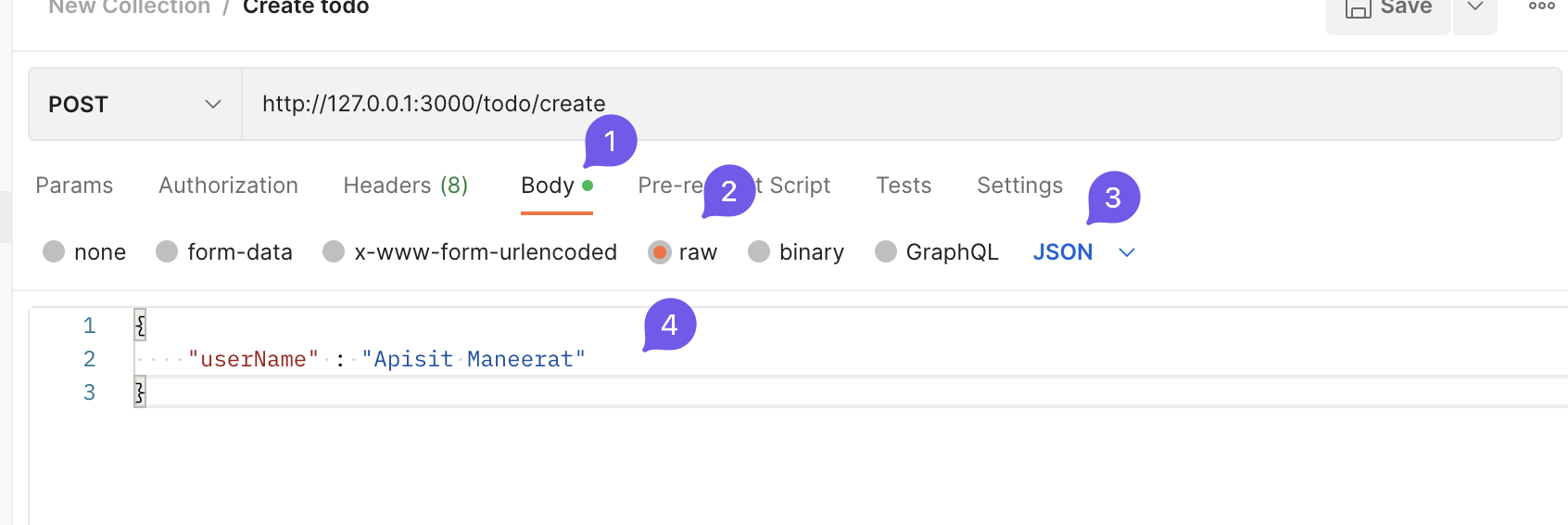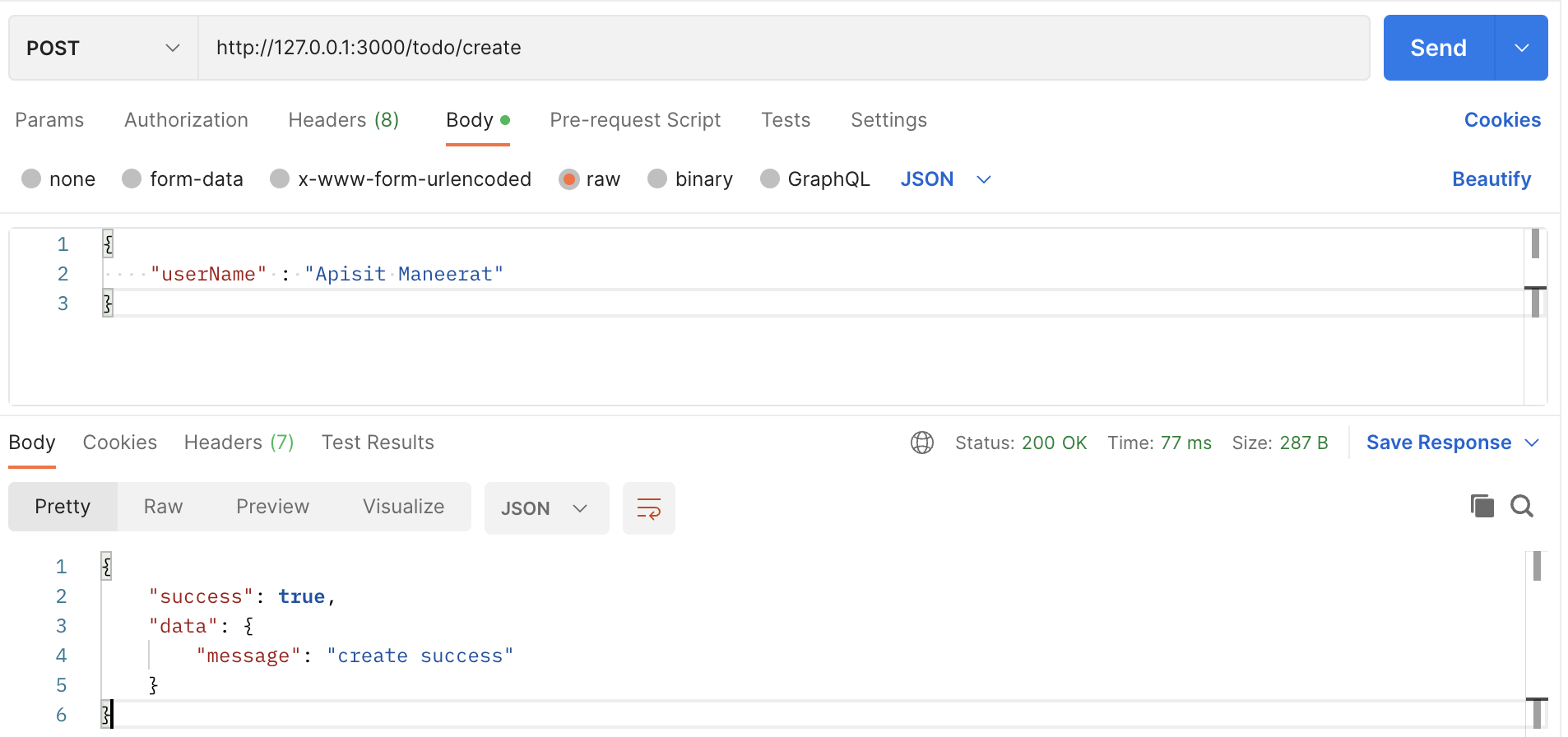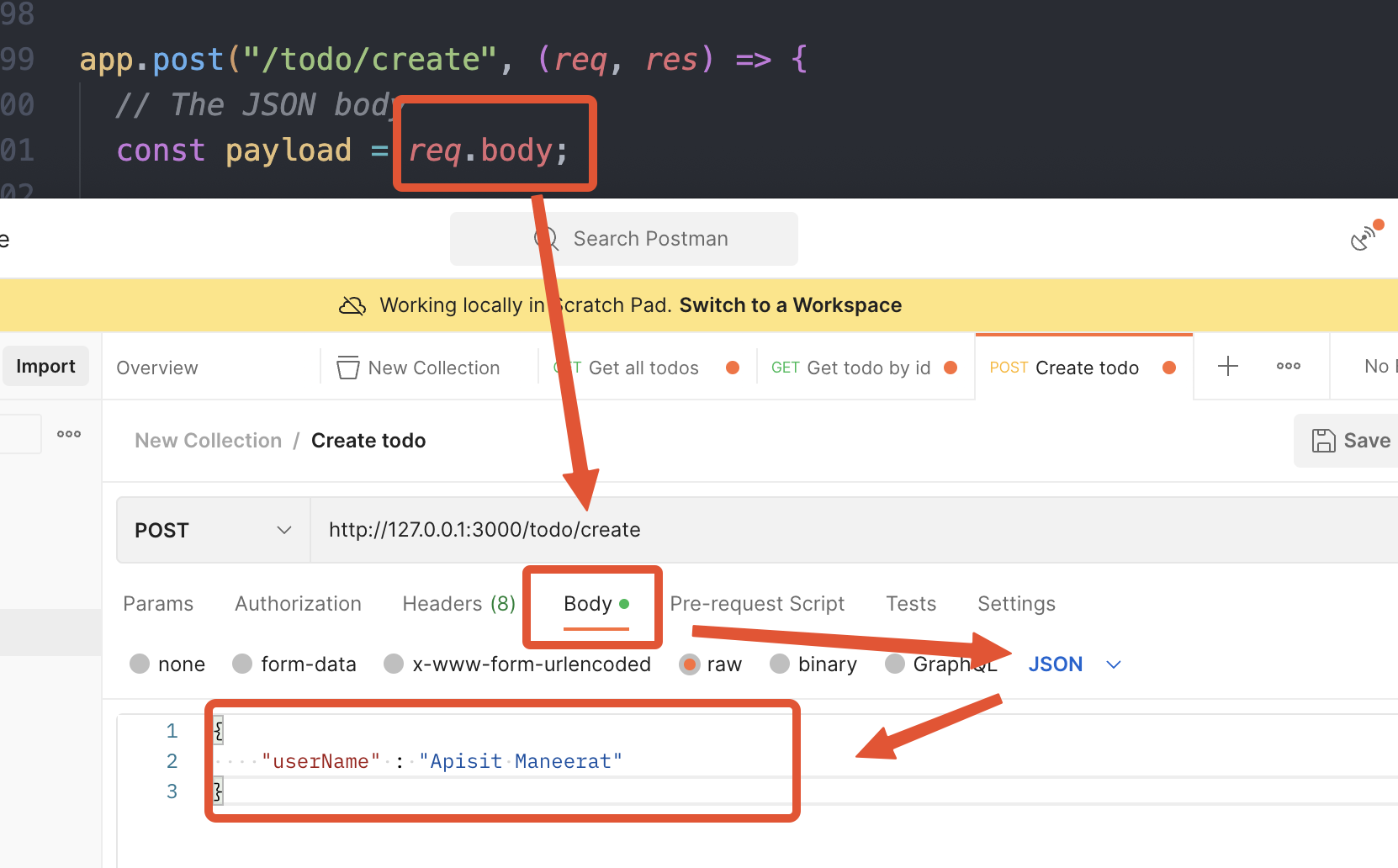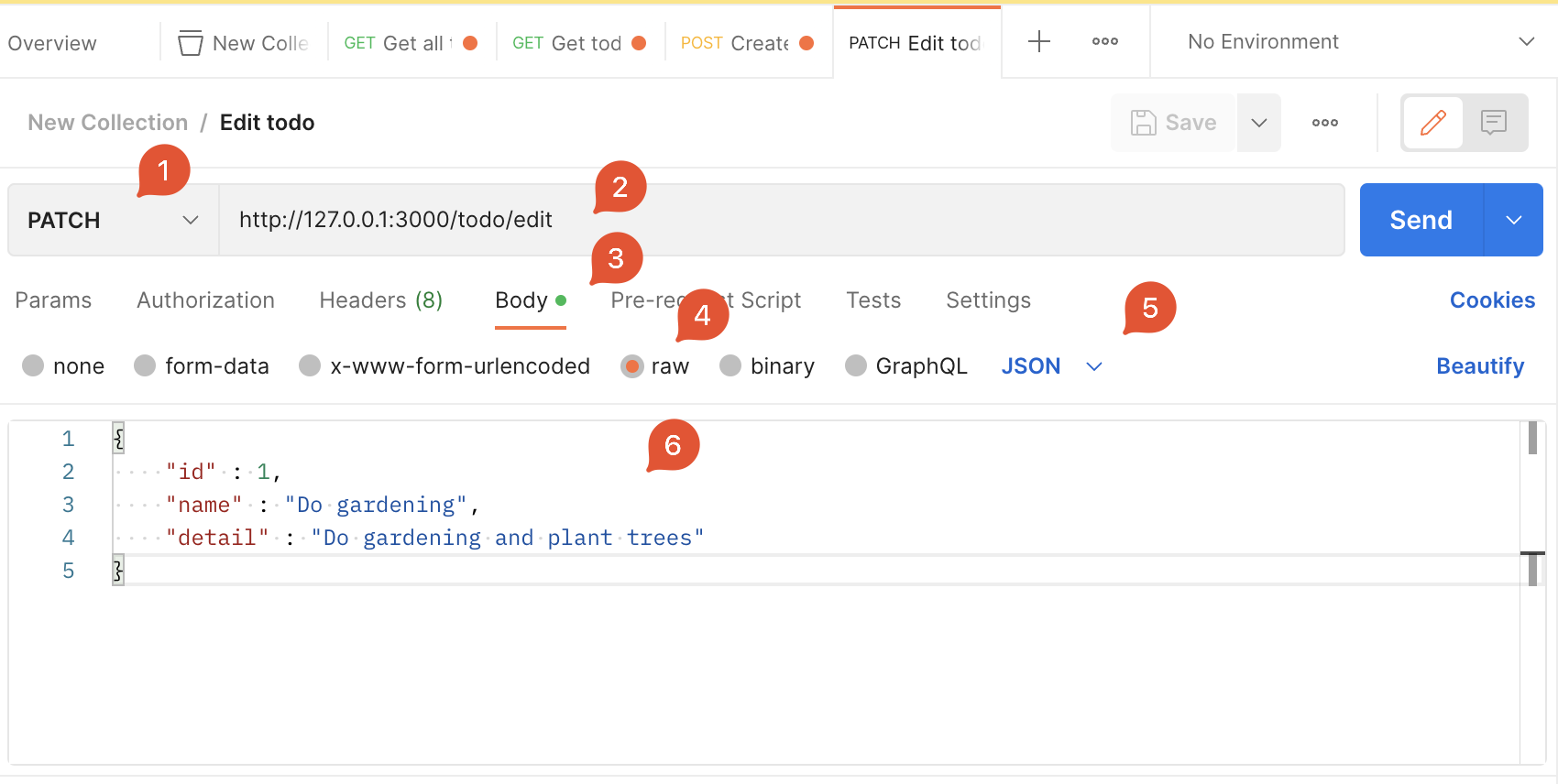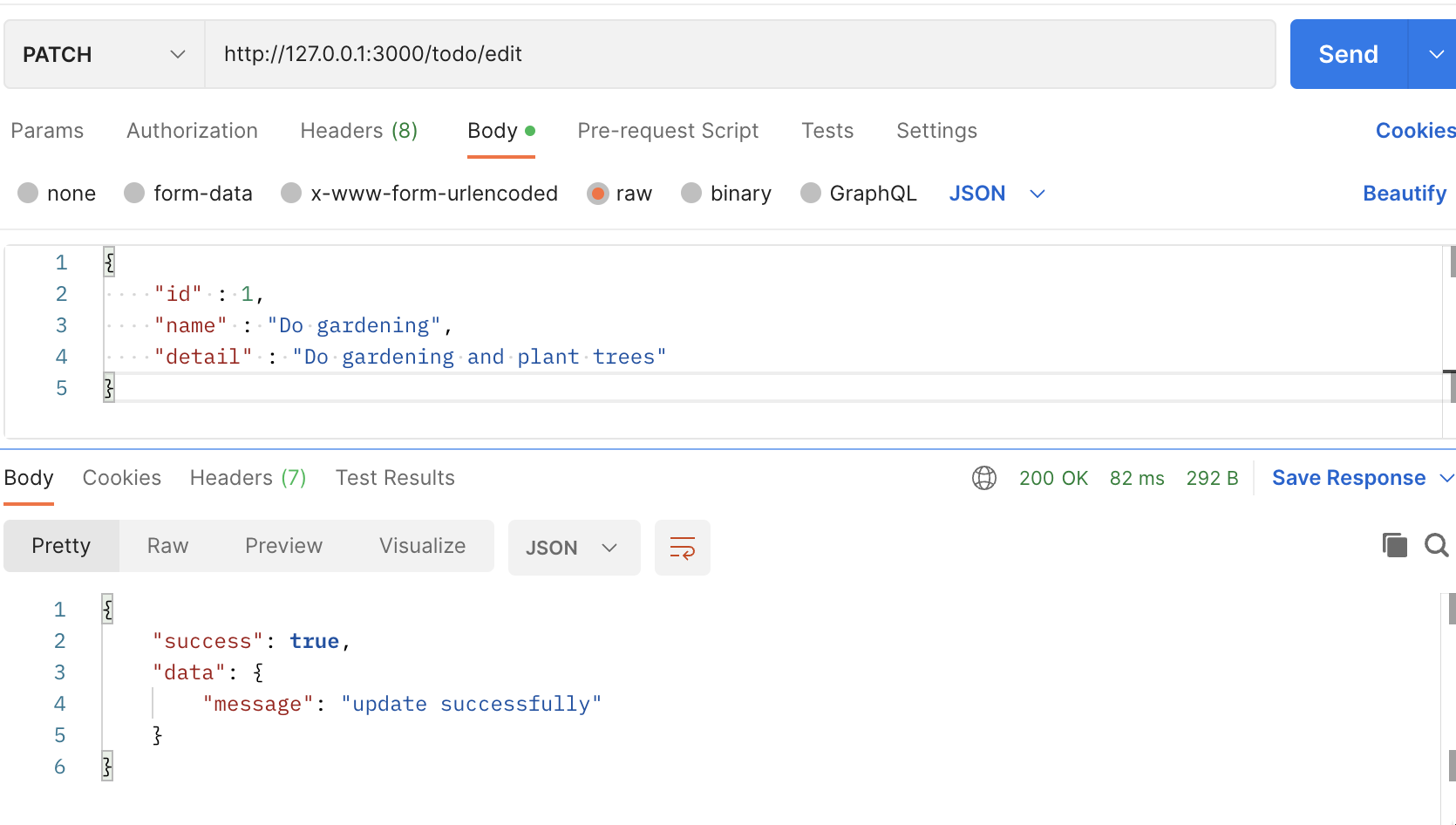Example of Update
- Let's create an endpoint to update user balance into the database, create
updateBalance.jsinto directorycontrollers->transactions
2. Write down using this code
const connection = require("../../services/database");
const updateBalance = async (req, res) => {
const { userId, amount } = req.body;
// Check if userId and amount is number or not
const checkUserId = new RegExp(/^\d+$/).test(userId);
const checkAmount = new RegExp(/^\d+$/).test(amount);
// Return error if the userId and amount are null or it's not a number
if (!userId || !checkUserId || !amount || !checkAmount) {
return res.json({
success: false,
data: null,
error: "Invalid input",
});
}
// Update the balance
try {
await connection
.promise()
.query(`UPDATE users SET balance = ${amount} WHERE id = ${userId}`);
// Return success if balance is upadated
return res.json({
success: true,
data: null,
error: null,
});
} catch {
console.error("Error:", error);
return res.status(500).json({
success: false,
data: null,
error: error.message,
});
}
};
module.exports = updateBalance;3. Go to transaction.js in directory routers and add the line below, this time we will use patch() since we want to update a single value.
const express = require("express");
const getBalance = require("../controllers/transactions/getBalance");
//add this line 👇
const updateBalance = require("../controllers/transactions/updateBalance");
const transactionsRouter = express.Router();
transactionsRouter.get("/balance", getBalance);
//add this line 👇
transactionsRouter.patch("/update", updateBalance);
module.exports = transactionsRouter;4. Let's run your application again, and use postman with localhost:5000/transactions/update don't forget to change the HTTP METHOD POST,GET to PATCH then send the userId and the amount that we want to change it to in body with JSON
//example of JSON that we will be sending in the body
{
"userId":"1"
"amount":"50000"
}- You will see the result like this.
-END-
Example of thePOSTmethod
Create an endpoint that create auser
Before writing a request, we need to install the librarybody-parserfirst.npm i body-parserBecause Express JS cannot read the JSON body request directly, So we need to installbody-parserfirst.
const bodyParser = require("body-parser"); // import the body-parser
// parse various different custom JSON types as JSON
app.use(bodyParser.json({ type: "application/json" }));
Code ...
const express = require("express");
const app = express();
const mysql = require("mysql2");
const bodyParser = require("body-parser"); 👈🏻
const port = 3000;
const connection = mysql.createConnection({
host: "server2.mixkoap.com",
port: "6103",
user: "root",
password: "root_apisitmaneerat",
database: "csc105-workshop",
});
// Connect to database
connection.connect();
console.log("Database is connected");
// parse various different custom JSON types as JSON
app.use(bodyParser.json({ type: "application/json" })); 👈🏻
app.get("/", (req, res) => {
res.send("Hello World!");
});
.
.
.
.
.
.
Create an endpoint
app.post("/todo/create", (req, res) => {
// The JSON body
const payload = req.body;
connection.query(
`INSERT INTO users (username) VALUES (?)`, [payload.userName], (err, rows) => {
// Check if cannot find the data in the database then return the error
if (err) {
res.json({
success: false,
data: null,
error: err.message,
});
} else {
// Return data to the client if success
console.log(rows);
if (rows) {
res.json({
success: true,
data: {
message: "create success",
},
});
}
}
}
);
});
The request body mostly send inJSONformat 👆🏻Create a request in Postman and change the HTTP method toPOST
****Remark - HTTP Methods 👇🏻
Add theJSONbody 👇🏻
http://127.0.0.1:3000/todo/create
{
"userName" : "Apisit Maneerat"
}
ClickSend
The response from your backend application. 👆🏻In the Database 👇🏻
For more detail
Example of the PATCH method
Create an endpoint that edit the data in the Database
For example we are going to change thenameanddetailfromid = 1
Create the endpointFor this endpoint we use.patch()because we are going to editsomefields that you specific in the Database.
app.patch("/todo/edit", (req, res) => {
// The JSON body
const payload = req.body;
console.log(payload);
connection.query(
"UPDATE items SET name = ?, detail = ? WHERE id = ?", [payload.name, payload.detail, payload.id],
(err, rows) => {
// Check if cannot find the data in the database then return the error
if (err) {
res.json({
success: false,
data: null,
error: err.message,
});
} else {
// Return data to the client if success
if (rows) {
res.json({
success: true,
data: {
message: "update successfully",
},
});
}
}
}
);
});
Create a request in Postman
ClickSend
Example of the DELETE method
Create an endpoint that delete the data from thelinkstable in the database.
For this endpoint, we will use.delete()because we are going to delete data from the database.We usequery stringto get the data from the clientCreate an endpoint 👇🏻
app.delete("/todo/delete", (req, res) => {
// Assign the params as a variable
const id = req.query.id;
const todoId = req.query.todo_id;
connection.query(
`DELETE FROM links where id = ? AND todo_id = ?`, [id, todoId],
(err, rows) => {
// Check if cannot find the data in the database then return the error
if (err) {
res.json({
success: false,
data: null,
error: err.message,
});
} else {
if (rows) {
res.json({
success: true,
data: {
message: "delete successfully",
},
});
}
}
}
);
});
Create a request in Postman
ClickSend
--- End of the example ----
** This is the finalized code for this example 👇🏻
const express = require("express");
const app = express();
const mysql = require("mysql2");
const bodyParser = require("body-parser");
const port = 3000;
const connection = mysql.createConnection({
host: "server2.mixkoap.com",
port: "6103",
user: "root",
password: "root_apisitmaneerat",
database: "csc105-workshop",
});
// Connect to database
connection.connect();
console.log("Database is connected");
// parse various different custom JSON types as JSON
app.use(bodyParser.json({ type: "application/json" }));
app.get("/", (req, res) => {
res.send("Hello World!");
});
app.get("/hello", (req, res) => {
res.json({
name: "Apisit Maneerat",
nickName: "Mixko",
university: "KMUTT",
});
});
app.get("/todo/all", (req, res) => {
connection.query("SELECT * FROM items", (err, rows) => {
// Check if cannot find the data in the database then return the error
if (err) {
res.json({
success: false,
data: null,
error: err.message,
});
} else {
// Return data to the client if success
res.json({
success: true,
data: rows,
error: null,
});
}
});
});
app.get("/todo", (req, res) => {
// Assign the params as a variable
// https://medium.com/@joseph.pyram/9-parts-of-a-url-that-you-should-know-89fea8e11713
const todoId = req.query.todo_id;
// Regex to check the todo_is is a number only or not
const checkTodoId = new RegExp(/^\d+$/).test(todoId); // Boolean
// Check if the todo_id is not exist or is not a number, return json with an error
if (!todoId || !checkTodoId) {
res.json({
success: false,
data: null,
error: "todo_id is invalid",
});
}
connection.query(`SELECT * FROM items WHERE id = ${todoId}`, (err, rows) => {
// Check if cannot find the data in the database then return the error
if (err) {
res.json({
success: false,
data: null,
error: `Data not found ${err.message}`,
});
} else {
// Return data to the client if success
if (rows[0]) {
res.json({
success: true,
data: rows[0],
error: null,
});
} else {
res.json({
success: true,
data: null,
error: null,
});
}
}
});
});
app.post("/todo/create", (req, res) => {
// The JSON body
const payload = req.body;
connection.query(
`INSERT INTO users (username) VALUES (?)`,
[payload.userName],
(err, rows) => {
// Check if cannot find the data in the database then return the error
if (err) {
res.json({
success: false,
data: null,
error: err.message,
});
} else {
// Return data to the client if success
if (rows) {
res.json({
success: true,
data: {
message: "create successfully",
},
});
}
}
}
);
});
app.patch("/todo/edit", (req, res) => {
// The JSON body
const payload = req.body;
console.log(payload);
connection.query(
"UPDATE items SET name = ?, detail = ? WHERE id = ?",
[payload.name, payload.detail, payload.id],
(err, rows) => {
// Check if cannot find the data in the database then return the error
if (err) {
res.json({
success: false,
data: null,
error: err.message,
});
} else {
// Return data to the client if success
if (rows) {
res.json({
success: true,
data: {
message: "update successfully",
},
});
}
}
}
);
});
app.delete("/todo/delete", (req, res) => {
// Assign the params as a variable
const id = req.query.id;
const todoId = req.query.todo_id;
connection.query(
`DELETE FROM links where id = ? AND todo_id = ?`,
[id, todoId],
(err, rows) => {
// Check if cannot find the data in the database then return the error
if (err) {
return res.json({
success: false,
data: null,
error: err.message,
});
} else {
if (rows) {
res.json({
success: true,
data: {
message: "delete successfully",
},
});
}
}
}
);
});
app.listen(port, () => {
console.log(`Example app listening on port ${port}`);
});
More examples for those who want to create more than one query in one endpoint
app.get("/todo/from", async (req, res) => {
const userId = req.query.userId;
// User data
const userData = await new Promise((resolve, reject) => {
connection.query(
`SELECT * FROM users WHERE id = ?`,
[userId],
(err, rows) => {
if (err) {
res.json({
suceess: false,
error: err.message,
});
} else {
resolve(rows[0]);
}
}
);
});
// User's todos
const userTodos = await new Promise((resolve, reject) => {
connection.query(
`SELECT * FROM items WHERE owner_id = ?`,
[userId],
(err, rows) => {
if (err) {
res.json({
suceess: false,
error: err.message,
});
} else {
resolve(rows);
}
}
);
});
res.json({
success: true,
data: {
user_data: userData,
todos: userTodos,
},
error: null,
});
});

